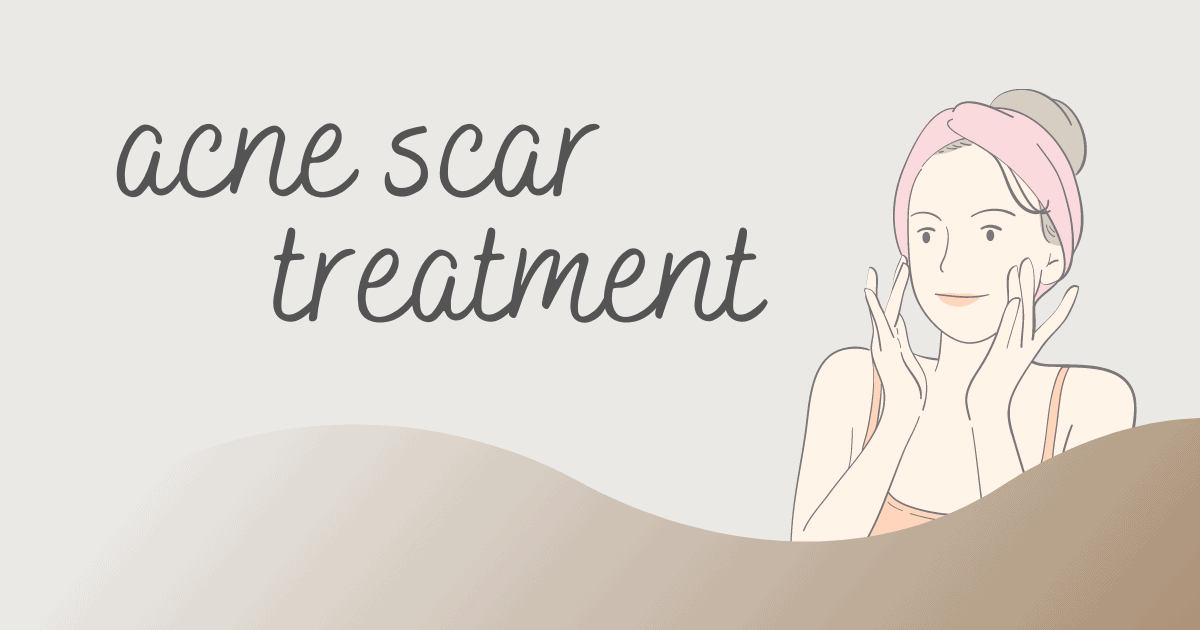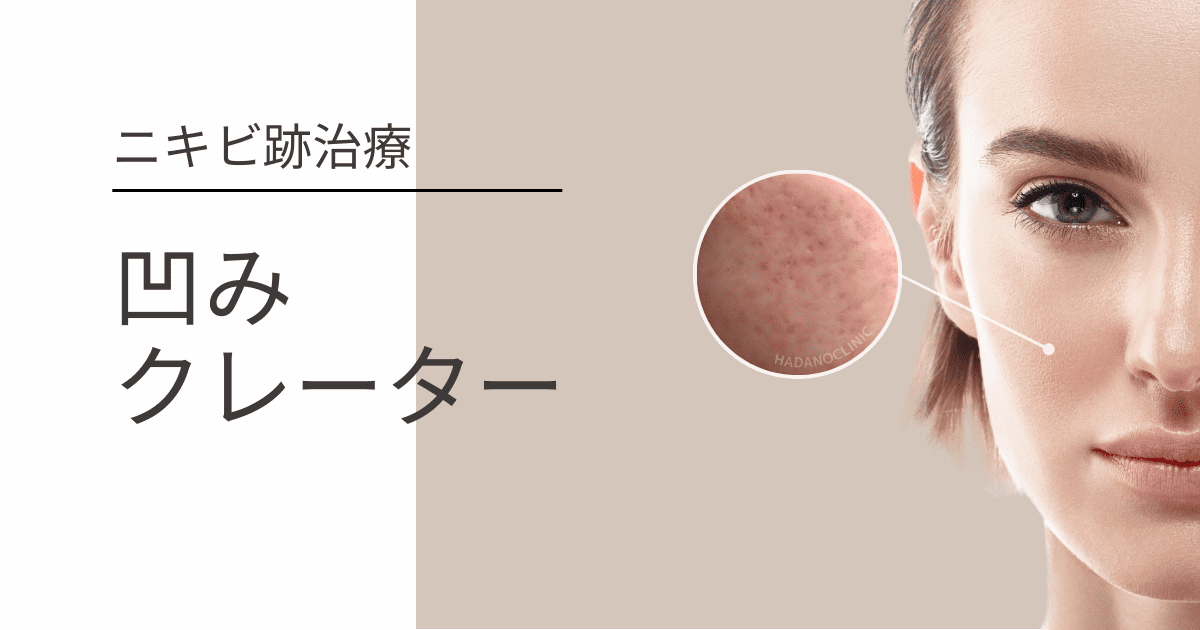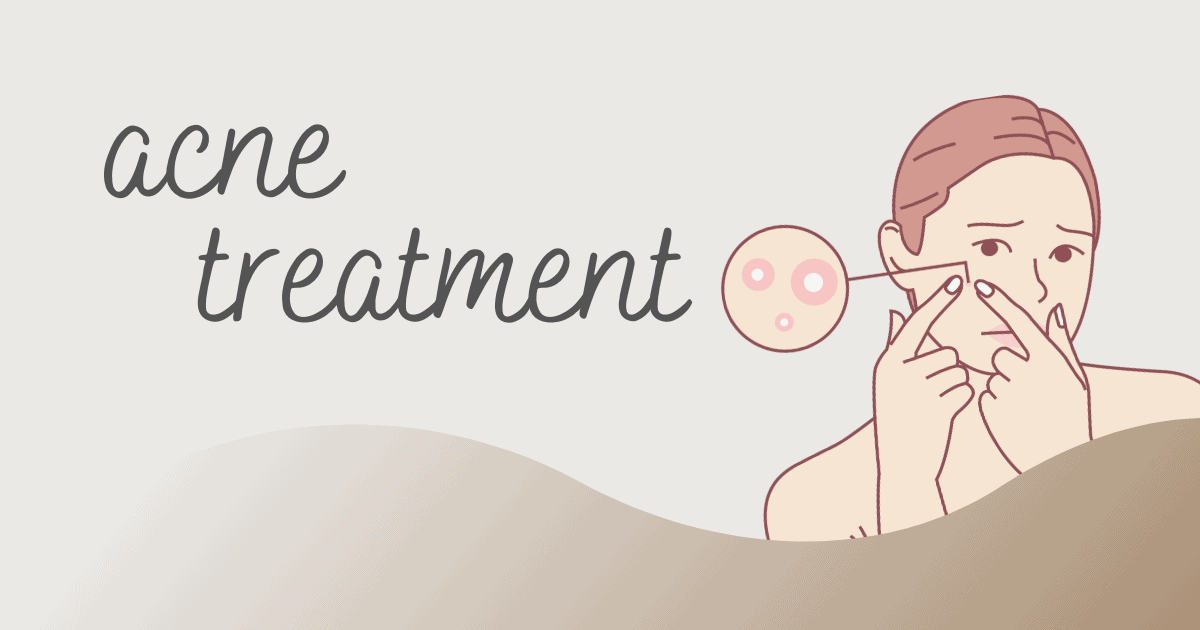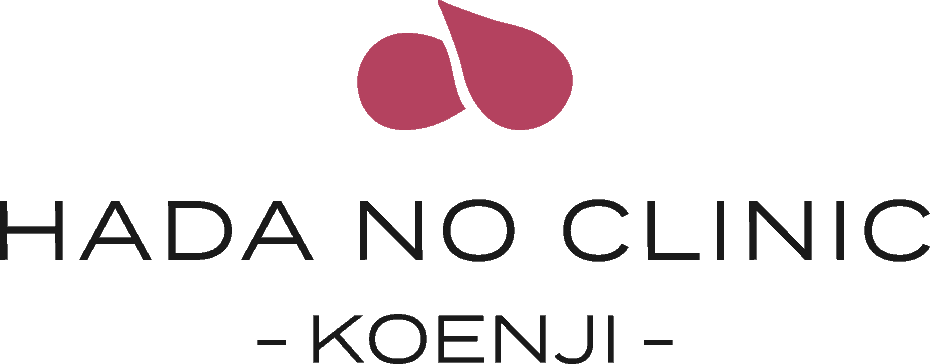Raised acne scars
If there is persistent raised texture even though the acne itself has healed, it is possible that acne scarring known as hypertrophic scars or keloids has formed.
Hypertrophic scars and keloids
Raised acne scars are referred to as hypertrophic scars, while those with strong redness and a tendency to enlarge are called keloids. They often occur in areas of the body that are prone to skin stretching, such as the jawline, chest, shoulders, back, and lower abdomen.
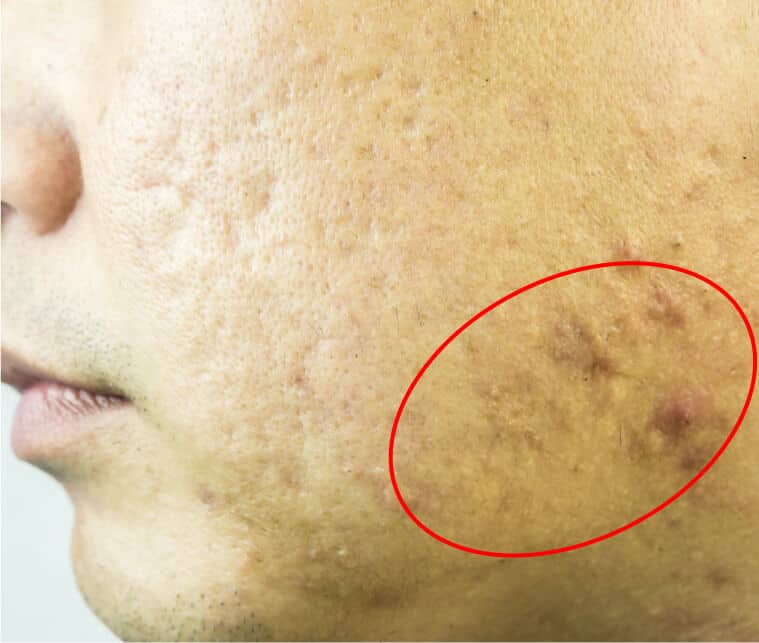
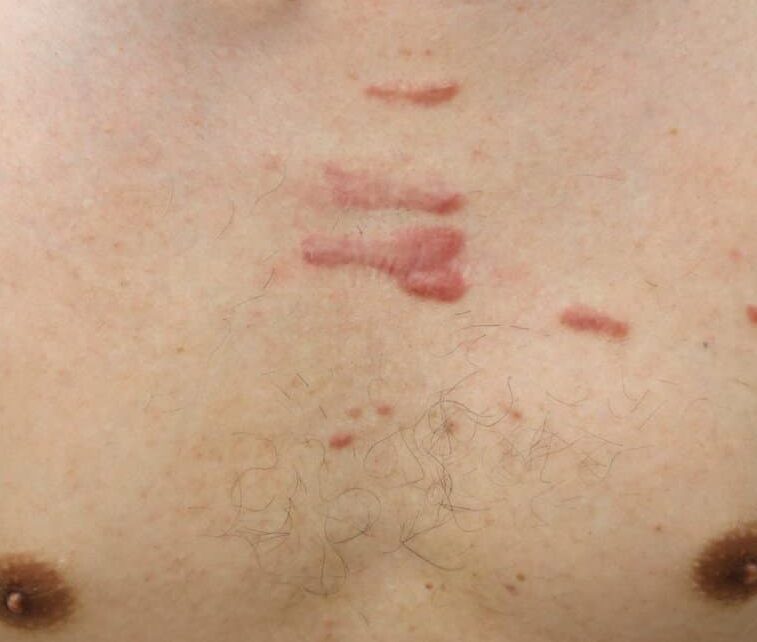
Both hypertrophic scars and keloids are formed by the accumulation of collagen fibers, which occurs as a result of abnormal or delayed healing of acne. Excessive scar tissue is produced, leading to raised areas. It is difficult to distinguish between the two histologically.
While some hypertrophic scars naturally improve over time, many can persist as “nodules” for years. Keloids, on the other hand, tend to expand beyond the boundaries of the original injury and are resistant to treatment, with a high likelihood of recurrence. It is also possible for hypertrophic scars and keloids to coexist within a single scar.
Treatment and Fees for Hypertrophic Scars and Keloids
Depending on the symptoms, a combination of various methods will be used for treatment. The treatment duration is typically around 1 to 4 years.
Important Points for Treatment
The most crucial aspect of treating hypertrophic scars and keloids is to avoid putting tension (stretching force) on the skin. Therefore, it is necessary to protect the scar from stimulation and tension using a silicone gel sheet called “Ato fine,” which will be mentioned later.
- 1.Ato fine(Silicon gel sheet)
-
- Features
- A crucial treatment that prevents tension on the skin. It helps prevent the proliferation of hypertrophic scars and keloids.
- How to use
- Apply a silicone gel sheet that is larger than the affected area once every 5 to 7 days. Please keep pasting as long as the sheet does not come off.
- Side effects
- Tape allergy has been reported. There are no serious side effects.
- Fee
- ¥1,980 per box (L: 6 pieces / S: 12 pieces / SS: 24 pieces).
- Features
- 2.Kenacort injection (Steroid injection)
-
- Features
- Strong steroid injection. It softens hardened tissue and flattens raised areas.
- Treatment method
- A mixture of Kenacort and an anesthetic is injected 6 to 12 times monthly.
- Those who cannot receive treatment
- Allergy to anesthesia, peptic ulcer, mental illness, tuberculosis, herpetic keratitis, cataracts, glaucoma, hypertension, diabetes, history of thrombosis, liver dysfunction, hepatitis, renal dysfunction, recent major surgery, osteoporosis, hypothyroidism, scleroderma.
- Side effects
- There is a risk of excessive indentation. Swelling, pain, and bruising at the injection site may occur. Other possible side effects include menstrual irregularities, acne, folliculitis, rash, skin atrophy, vasodilation, rosacea-like dermatitis, increased hair growth, depigmentation, and skin infections. Serious side effects that have been reported include infection, adrenal insufficiency, diabetes, peptic ulcer, pancreatitis, psychiatric disorders, depression, seizures, osteoporosis, aseptic necrosis of the bone, myopathy, cataracts, glaucoma, thrombosis, anaphylactic shock, asthma attacks, visual impairment, and tendon rupture.
- In our clinic, the maximum total injection amount is 5mg, and the usual injection amount per site is below 1mg, so the occurrence of serious side effects is extremely rare.
- Fee
- ¥3,190 for 1-2 sites / ¥880 for each additional site.
- Features
- 3.Botulinum toxin injection (Coretox)
-
- Features
- It helps to relieve tension in the muscles and skin, and reduces inflammation in keloids.
- Botulinum toxin injections are as effective as Kenacort injections and require half the number of injections, with fewer side effects.
- A combination of Kenacort injections and botulinum toxin injections may alternate monthly.
- Treatment method
- Injected 3-6 times every 2 months, using approximately 4 units per 1 cm.
- Those who cannot receive treatment
- Individuals with systemic neuromuscular junction disorders or severe muscle weakness, those who are pregnant, breastfeeding, or actively trying to conceive, and individuals with a known history of allergy to botulinum toxin therapy or polysorbate (additive).
- Side effects
- Swelling, pain, bruising, and headache at the injection site. In the case of facial treatment, there may be side effects such as temporary loss of expression in the injected muscles, but they typically resolve within 1 to 2 months. Severe allergic reactions (anaphylactic shock) have also been reported but are extremely rare.
- For women, contraception is advised until two menstrual cycles have occurred after the injection. For men, contraception is advised for three months following the injection.
- Fee
- ¥4,400 for 4 units / ¥4,400 for every additional 4 units. * 4 units will be injected per 1 cm.
- Features
- 4.Laser treatment for keloids
-
- Features
- This treatment targets hypertrophic scars and keloids with redness. We use lasers to destroy and shrink tiny blood vessels, improving the color of the scar. As its effectiveness alone is limited, it is performed in conjunction with other treatments.
- Treatment method
- The treatment method involves laser sessions at monthly intervals, with a duration of 1-2 years.
- Those who cannot receive treatment
- Individuals with sunburn on the treatment area, photosensitivity or sun allergy, pregnant women, individuals with epilepsy seizures, individuals with gold threads in the treatment area, individuals with tattoos, permanent makeup, or non-removable foundation (such as BB Glow, CC Glow), individuals using medications that increase photosensitivity.
- Side effects
- Redness, rash, post-inflammatory hyperpigmentation, hair loss in the treated area, melasma, burns, depigmentation (loss of pigment).
- Fee
- Up to 2 cm² ¥5,500 / 2-5 cm² ¥9,900 / 5-10 cm² ¥19,800.
- Features
- 5.ECLAR Plasters(Steroid tape)
-
- Feature
- Gradually flattens the raised areas of hypertrophic scars and keloids.
- How to use
- Cut to an appropriate size according to the affected area, avoiding contact with healthy skin as much as possible. Apply once a day and keep it on for 24 hours. It is recommended to cut the tape slightly smaller than the scar. If wearing it for 24 hours is difficult, apply it for approximately 12 hours.
- If using together with Ato fine (silicon gel sheet), apply a smaller piece of ECLAR Plastars first and then a larger piece of Ato fine on top.
- You can continue using the tape for more than 2 days to avoid the risk of irritation that may occur with frequent tape changes.
- Side effects
- Dermatitis, irritation, rash, skin atrophy, acne, folliculitis, vasodilation, rosacea-like dermatitis, excessive hair growth, depigmentation, and skin infections. Prolonged use around the eyes has been associated with reports of glaucoma and cataracts.
- Fee
- ¥220 per sheet.
- Feature
- 6.Tranilast (brand name: Rizaben)
-
- Features
- It inhibits the function of fibroblasts and has anti-allergic effects, preventing swelling and itching.
- Dosage
- Take one tablet three times a day after meals.
- Side effects
- Reported side effects include rash, itching, abdominal pain, nausea, vomiting, headache, dizziness, insomnia, fatigue, irregular menstruation, palpitations, edema, fever, oral ulcers, anemia, hair loss, liver dysfunction, renal dysfunction, frequent urination, painful urination, and decreased blood cell components. Severe side effects are extremely rare.
- Fee
- ¥22 per tablet / 90 tablets (1-month supply) for ¥1,980.
- Insurance dermatology clinics offer lower prices.
- Features
- Women who are pregnant, breastfeeding, or trying to conceive should not undergo any treatment except for treatment with Ato fine.
- Please note that in Japan, the combination of private medical treatment and insurance medical treatment is not permitted, so all treatments at our hospital are self-funded. If you wish to receive treatment covered by insurance, we recommend that you consult a dermatologist near you.
- If you have received the same laser treatment or injection before and do not need to see a doctor, there is no re-examination fee.
- If you purchase topical medicines for the second time and do not need to see a doctor again, the re-examination fee will not be charged.
List of References and Websites
- Koike S, (2015) “Nd:YAG Laser Treatment for Keloids and Hypertrophic Scars: An Analysis of 102 Cases.” Plast Reconstr Surg Glob Open 2015 Jan 8;2(12):e272. doi: 10.1097/GOX.0000000000000231. PMID: 25587506
- 小川 令 “ケロイド・肥厚性瘢痕の予防と治療” 日本医事新報社, 2019.03.11
- 瘢痕・ケロイド治療研究会 “ケロイド・肥厚性瘢痕 診断・治療指針 2018” 全日本病院出版会, 2018.07.11
- Shaarawy E, Hegazy RA, Abdel Hay RM. Intralesional botulinum toxin type A equally effective and better tolerated than intralesional steroid in the treatment of keloids: a randomized controlled trial. J Cosmet Dermatol. 2015 Jun;14(2):161-6. doi: 10.1111/jocd.12134. Epub 2015 Mar 24. PMID: 25810045.
- Rossi A, Lu R, Frey MK, Kubota T, Smith LA, Perez M. The use of the 300 microsecond 1064 nm Nd:YAG laser in the treatment of keloids. J Drugs Dermatol. 2013 Nov;12(11):1256-62. PMID: 24196333.
- Koike S, Akaishi S, Nagashima Y, Dohi T, Hyakusoku H, Ogawa R. Nd:YAG Laser Treatment for Keloids and Hypertrophic Scars: An Analysis of 102 Cases. Plast Reconstr Surg Glob Open. 2015 Jan 8;2(12):e272. doi: 10.1097/GOX.0000000000000231. PMID: 25587506; PMCID: PMC4292254.
- Kumar K, Kapoor BS, Rai P, Shukla HS. In-situ irradiation of keloid scars with Nd:YAG laser. J Wound Care. 2000 May;9(5):213-5. doi: 10.12968/jowc.2000.9.5.25985. PMID: 11933330.
- Ogawa R. Long-Pulsed 1064 nm Nd:YAG Laser Treatment for Keloids and Hypertrophic Scars. 2020 Dec 8. In: Téot L, Mustoe TA, Middelkoop E, Gauglitz GG, editors. Textbook on Scar Management: State of the Art Management and Emerging Technologies [Internet]. Cham (CH): Springer; 2020. Chapter 32. PMID: 36351161.
- Oosterhoff TCH, Beekman VK, van der List JP, Niessen FB. Laser treatment of specific scar characteristics in hypertrophic scars and keloid: A systematic review. J Plast Reconstr Aesthet Surg. 2021 Jan;74(1):48-64. doi: 10.1016/j.bjps.2020.08.108. Epub 2020 Sep 20. PMID: 33645505.
- Soliman M, Etman Y, AbdElhameed A, Elsharaby R, Tawfik A. Comparative Study between Nd-YAG laser, fractional CO2 Laser, and combined Nd-YAG with fractional CO2 Laser in the Management of keloid: clinical and molecular Study. J Cosmet Dermatol. 2021 Apr;20(4):1124-1132. doi: 10.1111/jocd.13920. Epub 2021 Jan 11. PMID: 33373109.
- Leszczynski R, da Silva CA, Pinto ACPN, Kuczynski U, da Silva EM. Laser therapy for treating hypertrophic and keloid scars. Cochrane Database Syst Rev. 2022 Sep 26;9(9):CD011642. doi: 10.1002/14651858.CD011642.pub2. PMID: 36161591; PMCID: PMC9511989.
- Sohrabi C, Goutos I. The use of botulinum toxin in keloid scar management: a literature review. Scars Burn Heal. 2020 Jun 26;6:2059513120926628. doi: 10.1177/2059513120926628. PMID: 32637157; PMCID: PMC7323272.

